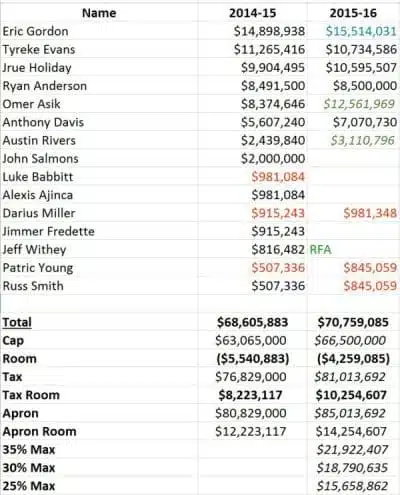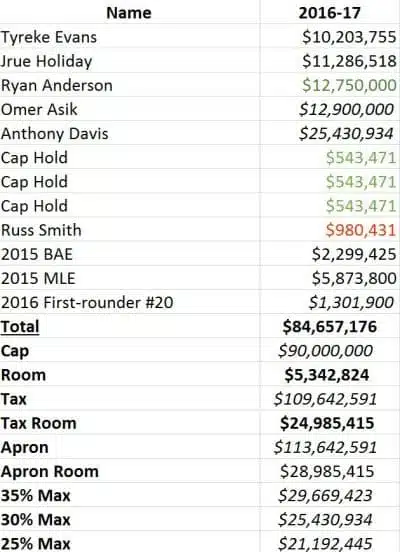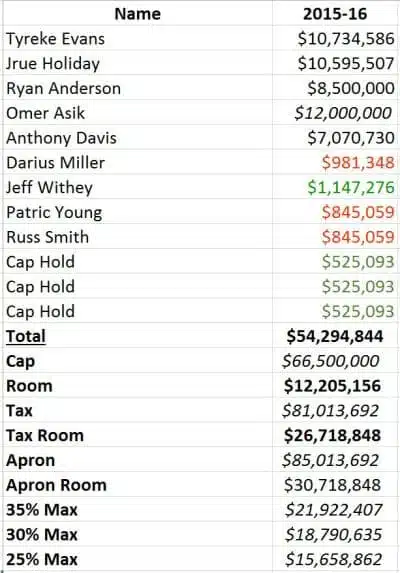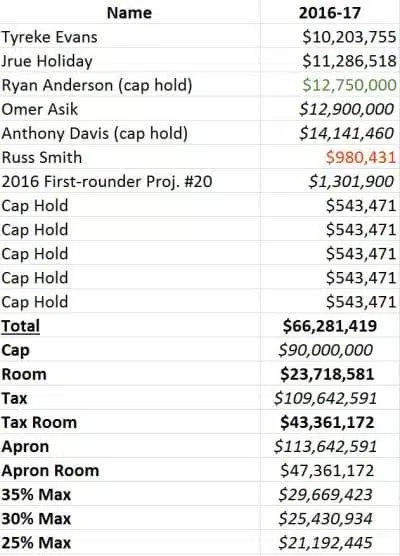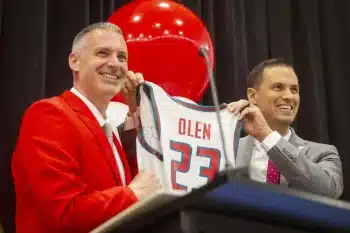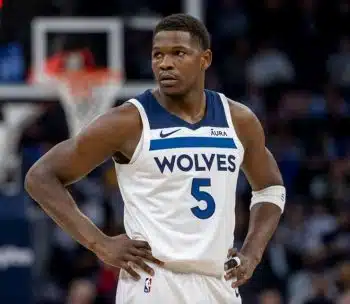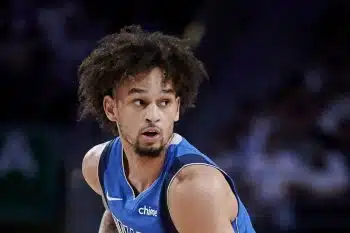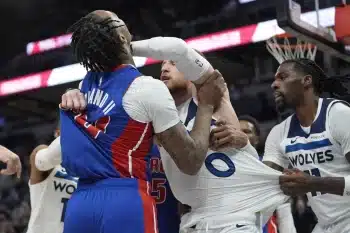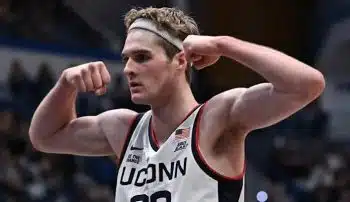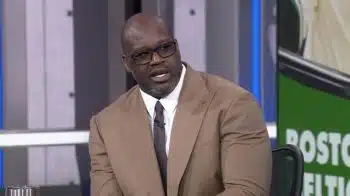NBA
NBA AM: The Pelicans’ Quest to Build a Contender
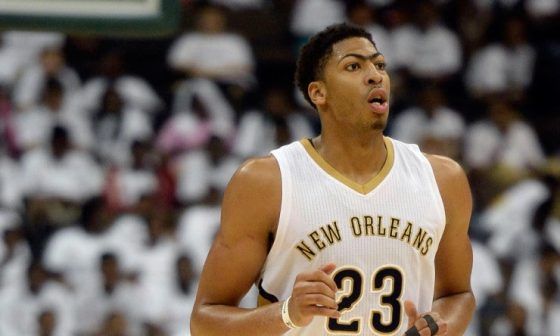
The Pelicans’ Quest to Build a Contender
With the ascension of Anthony Davis, the New Orleans Pelicans are suddenly at the forefront of the NBA discussion. By box score statistics, Davis has been playing about as well as any player possibly can over the 12 games to start the season. He has a 35.9 PER, 62 true shooting percentage, and is blocking 7.4 percent of opponents’ two-pointers. The Pels outscore opponents by 8.6 points per 100 possessions with Davis on the floor, and get murdered to the tune of -14.0 points/100 when he sits, per NBA.com. All of those numbers are almost certain to regress, if only because no player in NBA history has ever eclipsed a 32 PER over a full season, and the 10 seasons over 31 all belong to LeBron James, Michael Jordan and Wilt Chamberlain. Regardless, the Pelicans may already have the best player in the NBA on their hands, one who might be the favorite for MVP without accounting for team performance.
But it is that team performance that must worry Pelicans fans. Despite Davis’ otherworldly and likely unsustainable heroics, the Pels are only 7-6, good for 10th place in the brutal Western Conference. While they have done well with Omer Asik out of the lineup during their recent road trip, Eric Gordon is now out indefinitely with a torn labrum. Missing even one starter can be fatal for the Pels, as only Davis, Asik, Gordon, Jrue Holiday, Tyreke Evans and Ryan Anderson have any kind of track record as productive NBA players on this roster. At fourth in offense and 15th in defense through 12 games per Nylon Calculus, New Orleans has the overall statistical resume of a lower-rung playoff team. Yet even if the Pels can sneak into the playoffs as a lower seed, I don’t think anyone sees this core as a future championship contender. Holiday, Evans and Gordon add up to basically an average perimeter starting group despite raking in eight figures a year each in annual value over their contracts. They are all old enough that we should not expect massive improvements at this point. Evans is (rightly) starting at the three, but that is because there is not an NBA-quality small forward on the roster. He is not an adequate long-term solution at the position if the Pelicans are to improve defensively.
The Pels could potentially look to upgrade at coach from Monty Williams, although there is no guarantee that is a panacea. His rotations have been questioned at times,* and he needs to find a way to make a team with Asik and Davis outstanding defensively. But Williams is well-liked by his players and by all accounts an extremely high-character coach, so moving on from him may not be something the team is willing to contemplate unless they really crater.
Regardless of the coach, it is hard to imagine that this team has the talent on the perimeter to truly be a championship contender. So this team needs a personnel upgrade. How can they do it? Here is a projection of the Pels’ current salary situation. Note that Gordon is almost certain to exercise his 2015-16 player option for $15.5 million.
The main offseason priority will be re-signing Omer Asik. The Turkish center is one of the league’s best rim-protectors, and re-signing him will be imperative if the Pels hope to compete in the near-term. They can exceed the cap to re-sign him using Bird rights,* but if they do so it will likely be the end of any major additions. Unfortunately, if he leaves they will have only about $10 million in cap room. A contract starting at $10 million likely will not be enough in this market to sign a replacement player of Asik’s quality, especially if the Pels want him to commit past 2016 when the cap is set to explode to as much as $90 million. He would likely require a four- or five-year commitment starting at around $12 million per season with the maximum 7.5 percent annual raises.
Moreover, re-signing Asik will keep the Pelicans over the cap, allowing use of the $5.5 million mid-level exception (MLE) and $2.1 million bi-annual exception (BAE). If they have to replace Asik, they will have only the $2.8 million Room Exception and minimum contracts with which to work.
Re-signing Asik will also be an organizational priority because they surrendered a protected first-round pick to the Rockets to acquire him. That pick is top-three and top 20-30 protected, so it will almost certainly be conveyed this year unless the Pels really turn it on to finish with over 50 wins. That means 2015 will likely mark the third consecutive year New Orleans has not used its first-round pick.* The lack of picks in recent years is a big reason the Pels have such little depth. More importantly, it is the reason they have little hope of attaining the necessary improvement through internal development. Aside from Davis, they really have no young players who could realistically become a key part of a Pelicans contender.**
**Some might note that Austin Rivers has been better this year, but he had about as bad a first two years as an NBA player can have. That led to the decline of his fourth-year option, so he will be a free agent at the end of the year. If by chance he plays well enough to look like part of the future, the Pels will be limited to offering him a contract for what he would have made in his fourth year, about $3.1 million. Due to his performance and the fact he will likely leave if he improves significantly, he cannot be projected as a rotation piece going forward.
Even worse, while re-signing Asik would allow the Pels to retain their exceptions, acquiring a quality starter is rather difficult with those at this point. Unfortunately, as the cap grows those exceptions do not grow with it, as those were negotiated under previous CBAs. The type of player one can attract with those exceptions is much worse than a few years ago, when the cap was stagnant and fewer teams had cap room with which to trump the exceptions. What’s more, Asik’s cap hold (essentially a placeholder for the salary he is projected to sign for) is large enough that the Pels cannot add any further talent before re-signing him.
So 2015-16 will likely see the Pelicans with the same cast, plus another wing rotation player or two acquired with their exceptions. It is hard to imagine that squad moving beyond a ceiling of lower-run playoff team next year unless the West gets significantly worse or Holiday or Evans unexpectedly ascends to All-Star status.
So the Pels would have to target the summer of 2016, when Gordon comes off the books and the cap could be up to $90 million. The problem is that Davis’ five-year designated player max extension, which would be agreed to in the summer of 2015, will kick in by then. Ordinarily a player with four years of experience is limited to the “25 percent” max.* But Davis will very likely benefit from the Derrick Rose rule, which allows a max player to receive up to 30 percent of the cap if he 1) is voted MVP, 2) is voted in as an All-Star starter twice, or 3) makes two All-NBA teams in his first four years. Teams sometimes try to obtain a discount on this 30 percent max, but with a player as good as Davis the Pels would likely be foolish to seek any such concession.
Davis’ 2016-17 salary is therefore projected at a cool $25.4 million if the cap is $90 million. Throw in re-signing Ryan Anderson (who will have a $12.7 million cap hold), the players signed for the MLE and BAE in the summer of 2015, and the 2016 first-rounder, and the Pels likely will not have cap space for a difference-maker even in the halcyon summer of 2016. They would project at only around $5 million in space.
What’s worse, New Orleans would need to replace Gordon, who while overpaid is still a competent two guard when healthy. It is difficult to imagine the Pels coming out of that summer with a potential championship contender as Davis approaches his prime.
With staying the course unlikely to yield a contender, the Pels will have to get creative. One option might be doubling down on the future asset expenditures in the summer of 2015. Once the 2015 pick is conveyed to Houston, New Orleans can try trading its 2016 pick for the privilege of offloading Gordon’s contract a year early. That maneuver would leave it with around $12 million in cap space even after re-signing Asik.
They might focus on a 3-and-D wing like Danny Green, another quality backup wing and a reasonable backup point guard with the $2.8 million Room Exception. That still is not necessarily a championship contender, but with the right coaching one could construct a scenario in which that team becomes a dominant defense and still scores effectively enough to get into the mix with a few breaks. Of course, giving up a first-rounder four straight years is extremely concerning, but New Orleans’ management may decide more high-risk strategies are needed since they are already pot-committed.
Another potential strategy is even more fraught with disaster: New Orleans could wait to sign Davis until the summer of 2016 rather than giving him a maximum extension immediately, while swearing up and down to Davis and his representation that he would be taken care of with a five-year max once their free agency moves were complete. The benefit would be having his $14.1 million cap hold on the books instead of his $25.4 million salary. If they avoided using the MLE and BAE in the summer of 2015 for longer than one-year deals, the Pels could garner up to $23.7 million in cap space in the summer of 2016 by waiting to re-sign Davis until after they acquire free agents.
The risks would be astronomical though, because Davis would be a restricted free agent. If he were alienated, he could sign a three-year, third-year player option Chandler Parsons-style offer sheet and potentially leave New Orleans after the 2018 season once they matched. Potentially losing him three years too early to facilitate free agent signings would be quite the gambit, and one that would probably require an unrealistic amount of trust between the parties.
These scenarios do not represent the entire universe of alternatives. And it is difficult to project any NBA scenario two years out. But they do illustrate the type of gymnastics that will likely be required to add star talent around Davis. At one point New Orleans could have played it conservatively, sought to build around Davis in the draft, then added the missing pieces in free agency before the draft picks got expensive. Instead, they obtained those more expensive pieces in trades, used their free agent room in the process and lost the draft picks in the trades. Now, they have solid but expensive veteran talent, but no cheap depth and no apparent potential for acquiring a second star to pair with Davis in the foreseeable future. While we marvel at Davis’ incredible skills, we must also face the reality that assembling a contender around him could prove difficult indeed.
